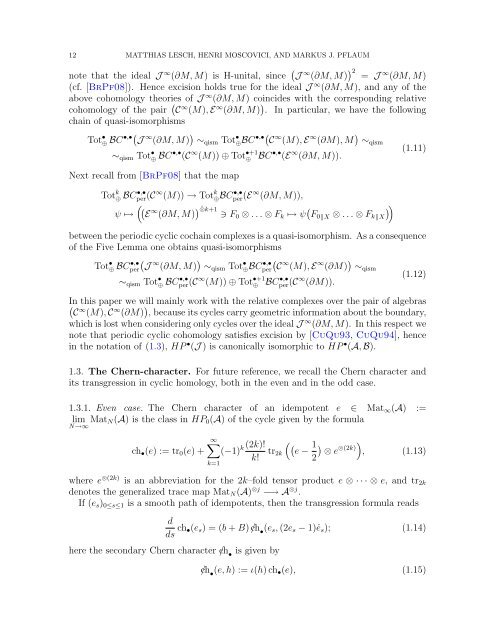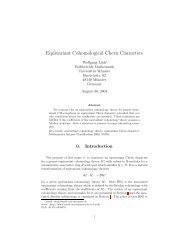Connes-Chern Character for Manifolds with Boundary and ETA ...
Connes-Chern Character for Manifolds with Boundary and ETA ...
Connes-Chern Character for Manifolds with Boundary and ETA ...
You also want an ePaper? Increase the reach of your titles
YUMPU automatically turns print PDFs into web optimized ePapers that Google loves.
12 MATTHIAS LESCH, HENRI MOSCOVICI, AND MARKUS J. PFLAUM<br />
note that the ideal J ∞ (∂M, M) is H-unital, since ( J ∞ (∂M, M) ) 2<br />
= J ∞ (∂M, M)<br />
(cf. [BrPf08]). Hence excision holds true <strong>for</strong> the ideal J ∞ (∂M, M), <strong>and</strong> any of the<br />
above cohomology theories of J ∞ (∂M, M) coincides <strong>with</strong> the corresponding relative<br />
cohomology of the pair ( C ∞ (M), E ∞ (∂M, M) ) . In particular, we have the following<br />
chain of quasi-isomorphisms<br />
Tot • ⊕ BC •,•( J ∞ (∂M, M) ) ∼ qism Tot • ⊕BC •,•( C ∞ (M), E ∞ (∂M), M ) ∼ qism<br />
∼ qism Tot • ⊕ BC •,• (C ∞ (M)) ⊕ Tot •+1<br />
⊕ BC •,• (E ∞ (∂M, M)).<br />
Next recall from [BrPf08] that the map<br />
(1.11)<br />
Tot k ⊕ BC per(C •,• ∞ (M)) → Tot k ⊕BC per(E •,• ∞ (∂M, M)),<br />
( (E<br />
ψ ↦→<br />
∞ (∂M, M) ) ˆ⊗k+1<br />
∋ F0 ⊗ . . . ⊗ F k ↦→ ψ ( ) F 0‖X ⊗ . . . ⊗ F k‖X<br />
between the periodic cyclic cochain complexes is a quasi-isomorphism. As a consequence<br />
of the Five Lemma one obtains quasi-isomorphisms<br />
(<br />
Tot • ⊕ BC per<br />
•,• J ∞ (∂M, M) ) ∼ qism Tot • ⊕BC per( •,• C ∞ (M), E ∞ (∂M) ) ∼ qism<br />
(1.12)<br />
∼ qism Tot • ⊕ BC per(C •,• ∞ (M)) ⊕ Tot •+1<br />
⊕ BC per(C •,• ∞ (∂M)).<br />
In this paper we will mainly work <strong>with</strong> the relative complexes over the pair of algebras<br />
(<br />
C ∞ (M), C ∞ (∂M) ) , because its cycles carry geometric in<strong>for</strong>mation about the boundary,<br />
which is lost when considering only cycles over the ideal J ∞ (∂M, M). In this respect we<br />
note that periodic cyclic cohomology satisfies excision by [CuQu93, CuQu94], hence<br />
in the notation of (1.3), HP • (J ) is canonically isomorphic to HP • (A, B).<br />
1.3. The <strong>Chern</strong>-character. For future reference, we recall the <strong>Chern</strong> character <strong>and</strong><br />
its transgression in cyclic homology, both in the even <strong>and</strong> in the odd case.<br />
1.3.1. Even case. The <strong>Chern</strong> character of an idempotent e ∈ Mat ∞ (A) :=<br />
lim<br />
N→∞ Mat N(A) is the class in HP 0 (A) of the cycle given by the <strong>for</strong>mula<br />
ch • (e) := tr 0 (e) +<br />
∞∑<br />
k=1<br />
(−1) k (2k)!<br />
k!<br />
( (e 1) tr 2k − ⊗ e<br />
⊗(2k))<br />
, (1.13)<br />
2<br />
where e ⊗(2k) is an abbreviation <strong>for</strong> the 2k–fold tensor product e ⊗ · · · ⊗ e, <strong>and</strong> tr 2k<br />
denotes the generalized trace map Mat N (A) ⊗j −→ A ⊗j .<br />
If (e s ) 0≤s≤1 is a smooth path of idempotents, then the transgression <strong>for</strong>mula reads<br />
d<br />
ds ch •(e s ) = (b + B) /ch •<br />
(e s , (2e s − 1)ė s ); (1.14)<br />
here the secondary <strong>Chern</strong> character /ch •<br />
is given by<br />
/ch •<br />
(e, h) := ι(h) ch • (e), (1.15)

















